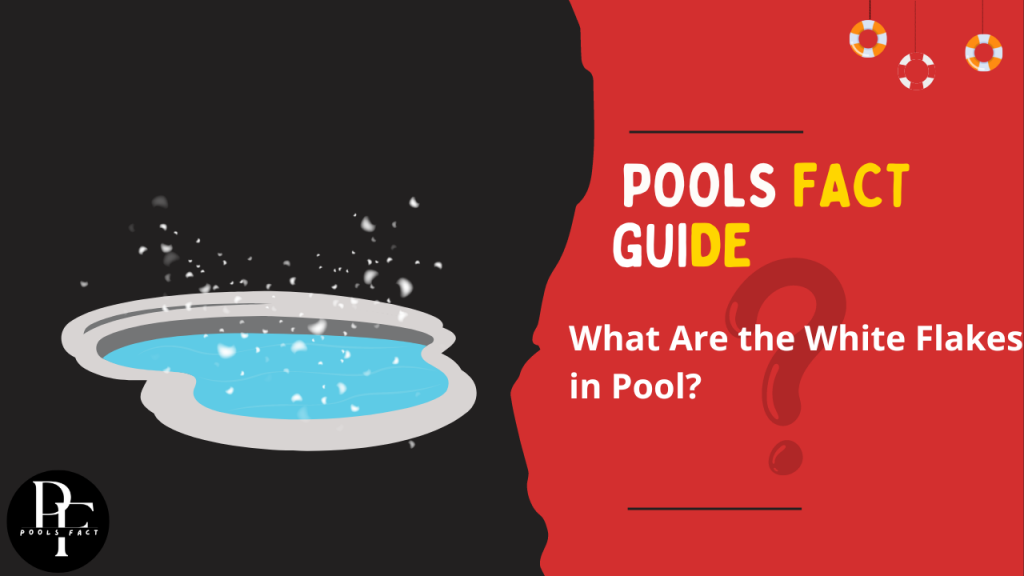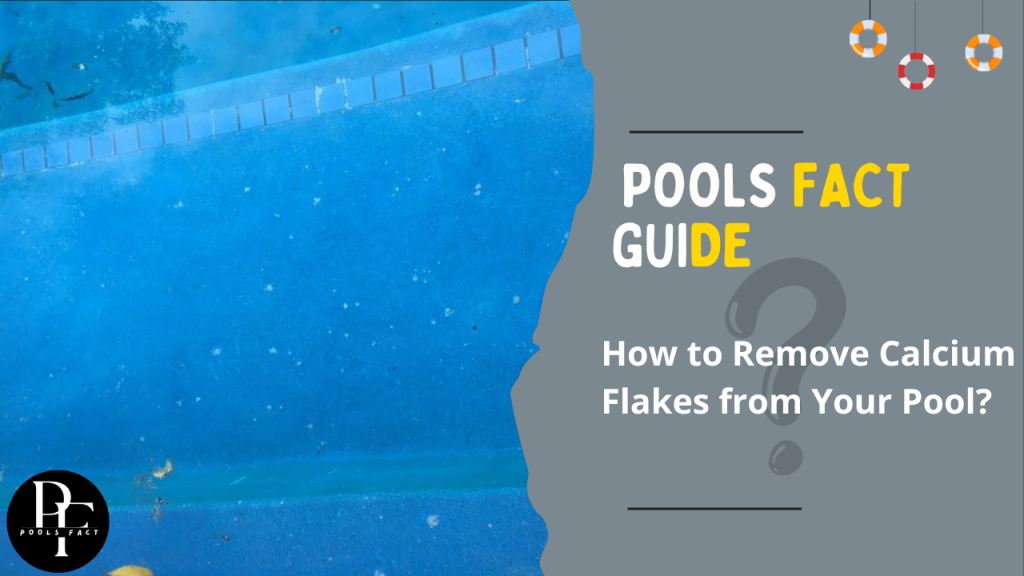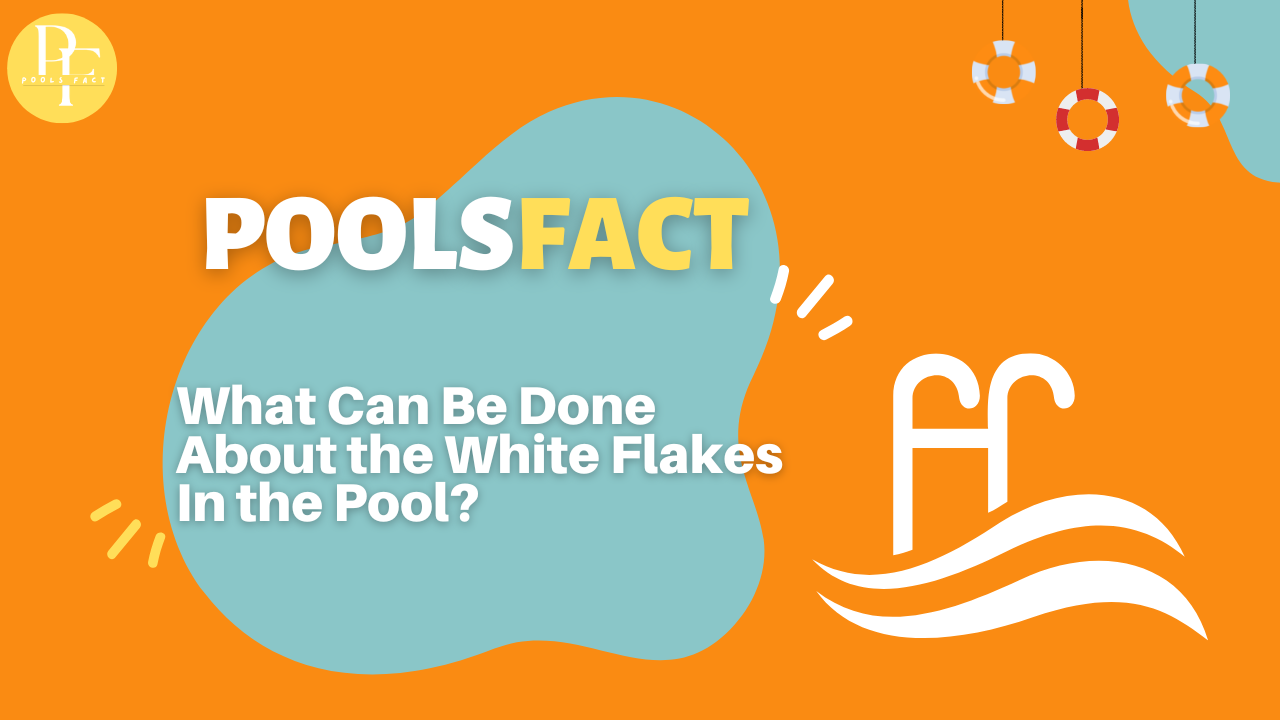You work hard to maintain the clarity of your saltwater pool, but the appearance of these white flakes in pool baffles you. They aren’t numerous, but there are enough of them to be problematic. What are these white flakes, and how can they be removed quickly?
The most common cause of white flakes in saltwater pools is calcium carbonate, which forms when the water is warm or the pH is high. In the saltwater chlorine generating cell, they are created, and then they are released into the water.
Run the filter or use a pool net to remove calcium flakes from the water. By maintaining a pH balance in your pool and keeping the salt cell clean, you can stop further buildup.
We know we just threw a lot of information at you, so we’ll break it all down later. We’ll first go into great detail on what calcium carbonate flakes are and where they come from. The removal and prevention of calcium flakes will then be covered.
Let’s get going!
What Are the White Flakes in Pool?
Let’s start by figuring out your mystery: the white flakes you see near the bottom of your pool are calcium carbonate flakes. They often come from the saltwater chlorine generator and enter your pool through the return pipe.

The electrolysis method used by the saltwater generator to produce chlorine uses electricity. Inside the salt cell, a component of the chlorine generator, are plates or blades that serve as electrodes. On the electrodes, calcium accumulates throughout this process. The white calcium flakes can enter your pool when it is loose and flaky because they can break off and migrate along pipes.
Have any of your dishes ever emerged from the dishwasher with a cloudy, white surface? The brilliance of those dishes persists even after hand washing them, right? The accumulation of minerals from hard water is to blame for this. Scale is the term for mineral accumulation.
On the bottom of kettles and occasionally on the edges of taps, you can also observe scale buildup.
Well, your saltwater pool can also develop scale. The electrolytic chlorine generator’s cell plates initially only experienced the issue. But over time, the calcium keeps accumulating in your pool and on the salt cell’s plates. The generator’s operation will be severely degraded as a result of this.
What Causes White Flakes in Saltwater Pool?
Unless you are using a pool heater or you have not been monitoring and balancing calcium hardness (CH), pH, total alkalinity, and other mineral levels, and these levels have gone exceedingly high, generating calcium scales in your pool, developing white flakes or calcium buildup in a non-saltwater pool is not frequent.
Due to the high temperature and pH of electrolytic chlorine generators and the fact that calcium is used to make the chlorine that goes into the pool, saltwater swimming pools naturally have a lot of calcium white flakes.
White flakes or calcium buildups in saltwater pools are caused by the slow accumulation of calcium scales in the salt cell plates of the chlorine generator.
When you first notice white flakes entering your pool through the entrance, it is already too late because calcium buildup has already penetrated the salt cell plates.
Sodium hydroxide (NaOH), a byproduct of the chlorine production process in a chlorine generator’s electrolytic salt cell, naturally raises pH levels in the salt cell and its surroundings.
Three factors are always present when calcium scales or white flakes occur, and they are as follows:
- Heat,
- Low pH and
- High levels of minerals
The salt cell and its surroundings are rich in all three of these elements.
As more scales build up on the plates in the salt cell, causing calcium buildup, you will notice white flakes flowing out of the return jets or water inlets and settling at the bottom of your pool near the inlet or floating on top of the water.
Scales and hazy pool water can be caused by calcium and other minerals, including phosphates, silicates, and sulfates. You can keep yourself safe by checking and changing the mineral levels in your pool on a regular basis.
The pH level in your pool water will drift up more frequently as a result of the steady production of sodium hydroxide byproduct and the high pH that results in the chlorine generator. This could make the situation in your pool worse by encouraging more calcium scales, which show up as white flakes in your pool.
So, if you have a saltwater chlorine generator and a pool water heater, you must keep an eye on your water chemistry by testing and adjusting the pH, TA, calcium hardness, and mineral levels to stop calcium scaling.
Calcium scales interfere with your water’s chemistry, particularly the pH, TA, chlorine level, and calcium hardness. They also shorten the lifespan of the complete chlorine generator.
Since white calcium flakes come from your chlorine generator, the first step to stop them in a saltwater pool is to use muriatic acid to check and clean the salt cell plates of your chlorine generator.
Also Read: What You Should Be Done with Your Pool When It’s Rain?
How to Remove Calcium Flakes from Your Pool
Scale is not a nice thing to have in your saltwater pool. Usually, calcium builds up towards the waterline. It appears to be either white or light grey. This looks like what you might see on the edge of a kettle or sometimes on the edges of a tap.

Also, too much calcium in the water can make the pool water look cloudy or milky, and in the worst cases, it can clog the heaters.
Fortunately, you can get rid of scale using a variety of techniques once you notice it. Here is what we advise.
Pumice Stone
Pumice works best on concrete and tile and can quickly dissolve calcium deposits. But you’ll have to work hard for it.
To be safe, we advise against using a pumice stone on fiberglass pools or on hard exterior tiles or surfaces. If you scrub your liner with a pumice stone, it will tear.
Scale Disposer
A descaling agent, often known as a scale remover, is a chemical that will scrape scale off crucial parts of your generator and perhaps even the remainder of your pool. The pool descaler from Clorox is designed to be poured right into your pool.
After that, you can use a scrubber to remove the scale of your pool’s walls. To prevent scale, Clorox advises using their descaler once a week. After using Clorox descaler to clean, you should analyze the water’s chemistry to make sure the chemicals are balanced.
Stain Eraser
You used Clorox’s descaler, and while it undoubtedly helped, your fiberglass or vinyl pool is still covered in mineral streaks. You could require a stain-specific product, such as the stain remover from Bosh Chemical.
This product comes in two-pound quantities and is ideal for thorough pool cleaning. Metal, fiberglass, and vinyl are just a few of the pool materials that Bosh claims their stain remover is safe to use.
Bosh’s stain remover is authorized for eliminating rust on metal pool accessories like your ladder and scale. Pour it in and then brush the stained area to apply it. The associated citrus aroma is mild and invigorating, and one canister can treat 20,000 gallons of pool water.
Also Read: Is Concrete Waterproof? You’re Concerned about Pool Waterproofing
How to Avoid Calcium Buildup and White Flakes in pools
There is always a chance that calcium carbonate particles will appear at the bottom of your saltwater pool. You simply have to accept that as the way the generator operates.
Balance LSI
In this case, LSI balance is critical. Weekly adjustments should be made to your water’s pH level to keep it from etching, but with enough room for the pH to rise without causing scale. There are various ways you may use the Orenda App calculator to implement this method, which is most likely the most crucial for preventing scaling flakes.
We suggest that you use a strategy of lower alkalinity and higher calcium to get a higher pH without making a scale.
Therefore, instead of decreasing it to 7.4 every week, think about doing it at a pH of 7.6 or 7.7, or even 7.8. We know the pH will increase until it reaches its equilibrium point because of physics (which we call the pH ceiling). Make use of this to your benefit! We’ll write another article on the approach to controlling the chemistry of saltwater pools in greater depth.
Balance the pool pH.
You shouldn’t go more than a week without monitoring the pH of your saltwater pool because the presence of sodium hydroxide raises the pH.
If you find that the pH is rising, you must bring it back down to the ideal range of 7.4 to 7.6. Your best friend will be a pH reducer.
Use sodium bisulfate or muriatic acid as appropriate. The pH level in your pool will be lowered by these two products.
Use SC-1000
SC-1000 can be used if LSI balancing and flushing of the cell are insufficient. Many pools, especially salt pools, receive SC-1000 treatments once a week as a simple preventative maintenance dose to help keep calcium in the solution.
Here is our process for chemically softening and removing the scale if you have problems. Additionally, there’s a considerable risk that your salt chlorine generator won’t be able to handle all the non-living organics in the pool eventually.
This is so that chlorine can effectively destroy microorganisms rather than remove the oxidant. You can reduce the amount of oil and other inorganic materials that could congeal in a salt cell and cause a problem.
Regularly clean and salt the cell
We didn’t go into great detail when explaining electrolysis. The salt cell uses plates with ruthenium-coated coatings. These plates or fins, which have a positive charge on one side and a negative charge on the other, are used to produce chlorine by using the salt in the water.
Scale buildup will start in the salt cells. One method to prevent this is to clean salt cells. You must first switch off your pool pump before cleaning the cells. You must then remove the salt cell.
In most cases, you may rinse the salt cell using a garden hose, but if the scale buildup is significant or if it is very stubborn, you may require a professional cleaning like BioGuard.
Also Read: You’re Apprehensive? Should I Get the Snow Removed from My Pool Cover?
Conclusion
In salt pools, calcium carbonate is usually invariably in the form of white flakes. Calcium flakes develop in pools when salt chlorine generators produce sodium hydroxide, a byproduct with a very high pH that causes scale to build in the salt cell.
The carbonate scale breaks and becomes looser as the salt cell reverses polarity, and flakes are then carried into the pool by the flowing water. We now have calcium flakes in pool.
Flakes are relatively simple to remove, but preventing them requires skill. Prevention necessitates an LSI approach to balancing the pool for the entire next week, not just today. Then, after the salt system shuts down, figure out a means to cool the salt cell down with additional circulation time.
white flakes in the pool, consider it a cool-down cycle. Finally, SC-1000 can be used as a weekly maintenance dose to avoid scale formation if you desire additional assistance in scaling prevention. We hope that this essay contributes to the topic’s clarification.

Leave a Reply